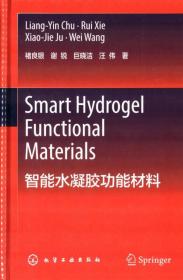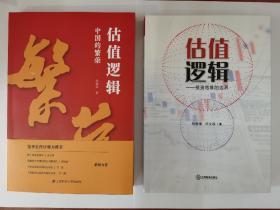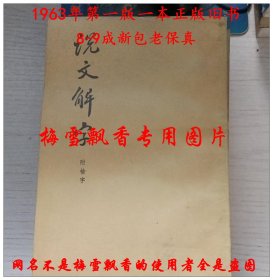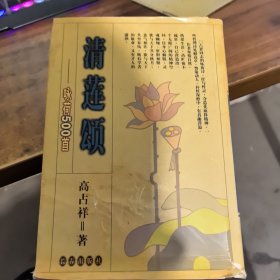
智能水凝胶功能材料:英文
¥ 1900 全新
库存5件
送至北京市朝阳区
运费快递 ¥8.00
作者褚良银、谢锐、巨晓洁、汪伟 著
出版社化学工业出版社
出版时间2014-02
版次1
装帧精装
货号6-2
上书时间2020-12-23
评价675好评率 99.87%
- 在售商品 暂无
- 平均发货时间 8小时
- 好评率 99.87%
- 最新上架
商品详情
- 品相描述:全新
图书标准信息
- 作者 褚良银、谢锐、巨晓洁、汪伟 著
- 出版社 化学工业出版社
- 出版时间 2014-02
- 版次 1
- ISBN 9787122176301
- 定价 280.00元
- 装帧 精装
- 开本 16开
- 纸张 胶版纸
- 页数 381页
- 字数 781千字
- 正文语种 英语
- 【内容简介】
-
《智能水凝胶功能材料(英文)》在国际上首次全面系统地介绍了现代智能水凝胶功能材料的构建、性能与应用,包括从大凝胶到微凝胶的设计思想、制备策略及方法、微结构及性能等,详细介绍了各种智能水凝胶功能材料的响应性能,如温度响应、pH响应、pH/温度双响应、葡萄糖响应、乙醇响应、离子识别响应、分子识别响应等。《智能水凝胶功能材料(英文)》大部分内容来自作者团队近年来在国家自然科学基金、国家973计划支持下取得的最新研究成果,是一本具有国际一流水平的学术专著。
- 【作者简介】
- 褚良银,(1967-),男,湖北五峰人,土家族,国家杰出青年基金获得者,教育部长江学者特聘教授,四川大学化工学院副院长,教育部“长江学者和创新团队发展计划”创新团队带头人,英国伯明翰大学化学工程学院名誉教授,中国化工学会理事,四川省过滤与分离重点实验室主任,中国膜工业协会专家委员会委员,成都市第十五届人民代表大会代表,中国人民政治协商会议第十届四川省委员会委员,四川省青年联合会第十一届委员会委员,九三学社四川大学委员会副主委等。《膜科学与技术》、《化工进展》、《中国科技论文在线》(化学/化工卷)、GlobalJournalofPhysicalChemistry、AdvancesandApplicationsinFluidMechanics、AmericanJournalofEnvironmentalSciences等国内外重要期刊主编与编委。
- 【目录】
-
PartⅠ Thermo.responsiveHydrogeIFunctionaIMaterials
1 Structure—Function Relationship ofThermo—responsive Hydrogels
1.1Introduction
1.2Effect oflnternal Microstructure on the Equilibrium Thermo—responsive Phase Transition
1.3Effect oflnternal Microstructure on the Dynamic Thermo—responsive Phase Transition
1.4Effect of Internal Microstructure on the Thermo—responsive Controlled—Release Characteristics
1.5 Effect oflnternal Microstructure on the MechanicalStrength of Thermo—responsive Hydrogels
1.6 Summary
References
2 Preparation and Properties of Monodisperse Thermo—responsive Microgels
2.1Introduction
2.2Submicron—Sized Monodisperse Thermo—responsiveCore—Shell Hydrogel Microspheres Fabricated via Surfactant—Free Emulsion Polymerization
2.2.1 Preparation of P(NIPAM—co—St) Seeds
2.2.2Preparation of Core—Shell Microsphereswith PNIPAM Shell Layers
2.2.3 Monodispersity ofCore—Shell Microsphereswith P(NIPAM—co—St) Cores and PNIPAMShell Layers
2.2.4 Thermo—responsive Characteristicsof the Core—Shell Microspheres with PNIPAM Shell Layers
2.3 Positively Thermo—responsive Submicron—SizedMonodisperse Core—Shell Hydrogel Microspheres
2.3.1Preparation ofPositively Thermo—responsive Submicron—Sized Monodisperse Core—ShellHydrogelMicrospheres
2.3.2 Morphological Analyses of the Microspheres
2.3.3 Positively Thermosensitive Swelling Characteristics
2.4 Monodisperse Thermo—responsive HydrogelMicrospheres and Microcapsules Preparedvia Membrane Emulsification
2.4.1Strategies for Preparation ofMonodisperse PNIPAM Microspheres and Microcapsules via Membrane Emulsificatio
2.4.2Morphology of Prepared MonodispersePNIPAM Microspheres
2.4.3Morphology of Prepared Monodisperse PNIPAM Microcapsules
2.4.4 Effect of Freeze—Drying and RehydratingTreatment on the Thermo—responsiveCharacteristics of PNIPAM Microspheres
2.5 Monodisperse Thermo—responsive Hydrogel Microspheres and Microcapsules Fabricated with Microfluidics
2.5.1Microfluidic Fabrication ofMonodisperseThermo—responsive Microgels with TunableVolume—PhaseTran sitionKinetics
2.5.2 FabricationofMonodisperse Thermo—responsive Microgelsin a Microfluidic Chip
2.5.3Fabrication ofMonodisperse Microspheres with PNIPAM Core and Poly(2—HydroxyethylMethacrylate) (PHEMA) She
2.6 Summary
References
3 Flow and Aggregation Characteristics of Thermo—responsive Microgels During Phase Transition
3.1 Introduction
3.2Flo and Aggregation Characteristics of Thermo—responsive Spheres During the Phase Transition
3.2.1 Preparation of Monodisperse PNIPAMHydrogel Spheres
3.2.2Thermo—responsive Volume—Phase Transition Characteristics of PNIPAM Hydrogel Spheres
3.2.3 Flow Characteristics of PNIPAM HydrogelSpheres During the Phase Transitionin a Transparent Glass Pipe
3.3Flow Characteristics of Thermo—responsiveMicrospheres in Microchannel During the Phase Transition
3.3.1 Synthesis of Microspheres in a SimpleMicrofluidic Device
3.3.2 Flow Characteristics of PNIPAMMicrospheres in Horizontal Microchannel at Low Reynolds Number of Fluid
3.3.3 Effect of the Diameter Ratio of PNIPAMMicrosphere to Microchannel on the FlowCharacteristics
3.4 Effects of Microchannel Surface Property on FlowBehaviors of Thermo—responsive Microspheres During the Phase Tran sition
3.4.1 Modification of Inner Surface of Glass Microchannel
3.4.2 Characterization of Wettability and Roughness of Modified Glass Microchannels
3.4.3 Effects of Surface Wettability and Roughnessof Microchannel on the Average Velocity of Fluid in Microchannel
3.4.4 Effect of Surface Wettability and Roughness of Microchannel on Aggregation Behaviorsof PNIPAM Microspheres During the Phase Transition
3.4.5Effect of Surface Wettability of Microchannel on Flow Characteristics of PNIPAM Microspheres
3.4.6 Effect of Surface Roughness of Microchannel on Flow Characteristics of PNIPAM Microspheres
3.4.7 Flow Behaviors of PNIPAM Microspheresin Microchannel with Hydrophobicand Rough Surface During the Phase Transition
3.5Summary
References
4 Polyphenol—Induced Phase Transition of Thermoresponsive Hydrogels
4.1 Introduction
4.2Phase Transition Behaviors of PNIPAM MicrogelsInduced by Tannic Acid
4.2.1Preparationof MonodispersePNIPAM Microgels
4.2.2 Dynamic Isothermal Volume—Phase Transition of PNIPAM Microgels Induced by TA
4.2.3Equilibrium Isothermal Volume—PhaseTransition of PNIPAM Microgels Induced by TA
4.2.4Thermosensitive Phase Transition of PNIPAMMicrogels in TA Solutions
4.3 Phase Transition Behaviors of PNIPAM MicrogelsInduced by Ethyl Gallate
4.3.1 Preparation of PNIPAM Microspheres and Core—Shell PNIPAM Microcapsules
4.3.2 Thermo—responsive Phase Transition Behaviors of PNIPAM Microspheres in EG Solution
4.3.3The Intact—to—Broken TransformationBehaviors of Core—Shell PNIPAM Microcapsules in Aqueous Solutionwith Varying EG Concentration
4.4 Summary
References
5 Functional Membranes with Thermo—responsive Hydrogel Gates
5.1Introduction
5.2Functional Membranes with Thermo—responsive Hydrogel Gates Fabricated by Plasma—InducedPore—Filling Graft Polymerizatio
5.2.1Regulation of Response Temperatureof Thermo—responsive Membranes
5.2.2 Effect of Grafting Degree on the Thermo—responsive Gating Characteristics
5.2.3Gating Characteristics of Thermo—responsiveMembranes with Grafted Linearand Cross—linked Hydrogel Gates
5.2.4Membranes with NegativelyThermo—responsive Hydrogel Gates
5.2.5 Composite Thermo—responsive Membrane System
5.2.6Thermo—responsive Affinity Membrane
5.3Functional Membranes with Thermo—responsive Hydrogel Gates Fabricated by Atom—Transfer Radical Polymerization
5.4Functional Membranes with Thermo—responsive Hydrogel Gates Fabricated by Free—Radical Polymerization
5.5Summary
References
6 Functional Microcapsules with Thermo—responsiveHydrogel Shells
6.1 Introduction
6.2 Functional Microcapsules with GraftedThermo—responsive Hydrogel Chains in the Porous Membranes as Gates
6.3 Functional Microcapsules with Thermo—responsiveMicrogels in the Membranes as Gates
6.4Functional Microcapsules with Thermo—responsiveCross—linked Hydrogels as Membranes
6.5Summary
References
为你推荐

妇产科病理学
七五品西宁
¥16.00

辨证录
八五品金华
¥6680.00

估值逻辑 投资思维的边界 中国的繁荣 两册合售 (包邮)
全新北京
¥165.00

限量毛边本· 麦家 著 · 台湾印刻文学版《人间信》(16开,一版一印)麦家的原生家庭之于他的影响 <家,越是远离,这里的一切就越与你有关。
全新北京
¥108.00

说文解字
八五品长春
¥32.00

牙体牙周组织病理学
八品襄阳
¥12.00

毛泽东选集 一卷本 大32开
八五品兰州
¥1225.00

毛泽东选集1 4卷
八品石家庄
¥226.00

限量布面精装编号本 · 台湾联经版 萧公权《中国政治思想史 (繁体竖排版)》(布面精装上下册)
全新北京
¥368.00

血液病骨髓组织病理学彩色图谱(精装)
九五品中山
¥11.00

【正版现货闪电发货】(4册)党员、党权与党争+中国历代党争史+传统十论+大目标:我们与这个世界的政治协商
全新南京
¥141.82

病理学
八品济源
¥12.00

病理学与病理生理学(第4版)
八五品滨州
¥3.03

1948:天地玄黄
八五品长沙
¥68.00

病理学 人民卫生出版社
九五品济南
¥2.97

晚饭花集1985
八五品银川
¥10.00

毛泽东选集一卷本32开,军军版,66年12月印制,是最早的一印,一军:解放军战士出版社翻印,二军:解放军1201工厂印刷,稀有品种
八五品锦州
¥1280.00

庄子今注今译(全三册)
九品萍乡
¥54.00

毛主席诗词
八五品石家庄
¥260.00

病理学图谱
八品武汉
¥10.00
— 没有更多了 —
微信扫码逛孔网
无需下载














非常不错👍
书好,价格实惠,防护到位。
非常满意。
赞👍